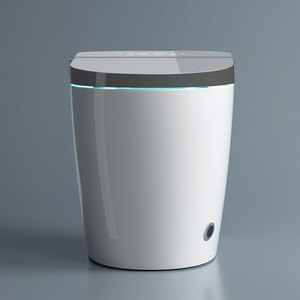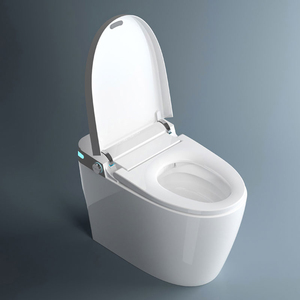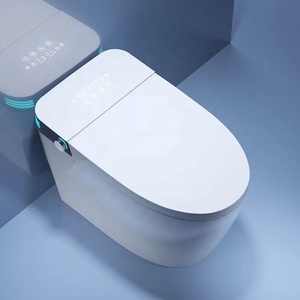(595854 products available)
































































































































 Ready to Ship
Ready to Ship







































































 Ready to Ship
Ready to Ship





A toilet is also known as a water closet, lavatory, or restroom. It disposes of human waste through a bowl connected via plumbing to a sewage system or septic tank. Toilets are essential for every home, and they come in different types. Here are some of them:
Composting Toilet
A composting toilet is a type of toilet that doesn't need water to operate. It uses a biological process to separate and decompose human waste into compost. The toilet relies on gravity or a simple hand-operated mechanism to remove solid waste from the bowl. It is an eco-friendly option that recycles human waste into usable compost, making it popular in off-grid locations or areas with limited water supply. The toilet is easy to install and maintain, and it is an excellent alternative for remote areas or sustainable homes.
Smart Toilet
A smart toilet is a high-tech bathroom fixture with advanced features for hygiene and comfort. Some of its features include automatic lid opening and closing, built-in bidet functions, heated seats, air dryers, and self-cleaning capabilities. It enhances the bathroom experience with features like seat temperature control, water pressure adjustment, and UV light cleaning. A smart toilet is convenient and hygienic, reducing the need for toilet paper. It is more expensive than traditional toilets and requires a power source and water connection.
Wall Mounted Toilet
A wall-mounted toilet is a contemporary style where the toilet is attached to the wall. This design exposes the floor, making the area look spacious and more accessible. The cistern is hidden inside the wall, and this toilet type uses a horizontal outlet. Wall-mounted toilets are modern and sleek and enhance the bathroom's appearance. They are more accessible for people with disabilities and are easy to clean due to the space underneath.
Two-Piece Toilet
Two-piece toilets are the most common; they are separate pieces. The tank and bowl are different parts that are connected. They are less expensive and easier to find than other models. The toilet is easy to install and repair, and it comes in various styles and prices. However, it requires more cleaning than the one-piece model because of the areas between the tank and the bowl.
One-Piece Toilet
A one-piece toilet merges the tank and the bowl into one unit. It has a sleek design that makes it look modern. Cleaning this toilet is easy because dirt and grime can't accumulate in the small spaces. However, one-piece toilets are more expensive, and their installation requires a professional.
When it comes to features and functions of the modern toilet, the list below summarizes the important aspects that should be considered before purchasing:
Toilet tank and bowl
The toilet tank is a reservoir for water, while the toilet bowl is the receptacle for human waste. These two components work together to form a complete toilet system.
Toilet seat and lid
A toilet seat and lid provide comfort and hygiene. Several kinds of toilet seats are available, including soft-close, heated, and bidet toilet seats. The toilet lid keeps the toilet bowl clean and hides it from view.
Flush handle or button
The flush handle or button releases water from the tank into the bowl to flush waste away. It is easy to operate and can be a lever, knob, or button.
Fill valve
The fill valve controls the water flow into the tank after a flush. It ensures the tank fills to the correct level for the next flush. The fill valve is crucial for the toilet's proper functioning.
Flapper valve
The flapper valve seals the tank and bowl, allowing water to flow during flushing. It controls the amount of water released and is responsible for the effective flushing action.
Overflow tube
The overflow tube prevents water from overflowing the tank by directing excess water into the bowl. It ensures the toilet functions properly and prevents water wastage.
Siphon jet flush system
A siphon jet flush system uses a siphoning effect to remove waste efficiently. It creates a powerful and quiet flush, conserving water while maintaining effective waste removal. This system is commonly found in modern toilets.
Gravity flush system
Toilets with a gravity flush system rely on the force of gravity to empty the tank and flush the bowl. It is the most common flushing system and is known for its reliability and simplicity. This system is prevalent in many households.
Concealed cistern
A concealed cistern is a hidden tank inside the wall that saves space and makes toilets look better. This design is common in modern and minimalist bathrooms and is easy to install and maintain.
There are many use case scenarios of modern toilets that are worth mentioning. These are:
Residential homes
Modern toilets are installed in residential homes. They provide a high level of comfort and convenience for homeowners. Features like heated seats, integrated bidets, and automatic flushing enhance the overall bathroom experience. Additionally, their water-saving technologies help homeowners to conserve water and reduce utility bills. Their sleek designs also contribute to the aesthetic appeal of residential bathrooms.
Commercial buildings
Modern toilets are also installed in commercial buildings. These include offices, hotels, restaurants, and shopping centers. The toilets provide comfort and hygiene to employees, guests, and patrons. Features such as touchless operation and self-cleaning functions reduce the spread of germs and minimize the need for manual cleaning. Moreover, their durable construction can withstand frequent use in high-traffic areas.
Healthcare facilities
Modern toilets are commonly found in healthcare facilities. These include hospitals, clinics, and nursing homes. Toilets such as wheelchair toilets are suitable for patients with disabilities or those who have mobility challenges. Special features like touchless operation and integrated bidets promote hygiene and reduce the risk of infections. Additionally, some modern toilets have built-in sanitization functions that ensure a clean and safe environment for patients and healthcare providers.
Educational institutions
Modern toilets are installed in educational institutions. These include schools, colleges, and universities. The toilets provide a comfortable and hygienic environment for students, teachers, and staff. Features like touchless operation and automatic flushing reduce the spread of germs in high-traffic areas. Additionally, modern toilets with water-saving technologies help educational institutions to conserve water and reduce their operating costs.
Public restrooms
Modern toilets are frequently installed in public restrooms. These locations include parks, airports, shopping malls, and stadiums. The toilets provide convenience and hygiene to a diverse range of users. Features like touchless operation and self-cleaning functions reduce the spread of germs and minimize the need for manual cleaning. Additionally, modern toilets designed for high-traffic areas are durable and easy to maintain.
There are various factors to consider when choosing the ideal toilet for a specific space. The following are some of them:
Consider the Space Available
The first step in choosing a toilet is to analyze the available space. Measure the distance from the wall to the floor where the toilet will be installed. This measurement will help determine the right size of the commode that can fit in that space. If the area is tightly spaced, consider a compact design like a one-piece or wall-mounted toilet.
Consider the Flush System
Different flush systems have unique features and benefits. The dual flush system provides options for liquid or solid waste, conserving water. The single flush system is simple and effective. The powerful flush system ensures complete waste removal in one go. Choose a flush system that meets the desired efficiency and performance requirements.
Check the Bowl Shape and Height
The toilet bowl shape impacts comfort and efficiency. Round bowls are space-saving, while elongated bowls offer more comfort. Also, consider the height of the toilet. Standard heights are between 14 and 15 inches. However, comfort height toilets are 16 to 19 inches high. They are ideal for people with mobility issues or those who prefer a higher seat.
Evaluate the Style and Configuration
Toilets come in various styles, including one-piece, two-piece, and tankless configurations. One-piece toilets have a sleek design since the bowl and tank are joined. Two-piece toilets are more popular because the bowl and tank are separate pieces. Tankless toilets provide the ultimate modern look, but they require a powerful flush. Choose a style that matches the bathroom design.
Look at the Additional Features
Modern toilets have advanced features that enhance convenience and hygiene. Heated seats make for a cozy experience during colder months. Night lights are useful for safe, easy use in the dark. Integrated bidet functions offer thorough cleaning and minimize toilet paper use. Assess which additional features will benefit the bathroom users.
Q1: What are smart toilets?
A1: Modern toilets are referred to as contemporary toilets. They are equipped with sophisticated features like automatic flushing, heated seats, and integrated bidet functions. They frequently have touchless sensors for flushing and lighting. These sensors enhance hygiene by preventing direct contact. Smart toilets also have built-in air dryers and deodorizers for added convenience. Some models offer adjustable water temperature and pressure settings. This promotes a more personalized and comfortable experience. In terms of waste disposal, these high-tech fixtures are even more environmentally friendly. They use less water per flush than traditional toilets. Additionally, many smart toilets have self-cleaning functions. This minimizes the need for harsh chemicals and promotes overall cleanliness.
Q2: What are the main components of a toilet?
A2: The essential parts of a toilet include the tank, bowl, flush mechanism, and fill valve. The tank stores water needed for flushing. Inside the tank, the flush mechanism and fill valve work together to release water when activated and refill the tank after each use, respectively. The bowl is where waste is collected and disposed of through the siphoning action created when the tank water is released during a flush.
Q3: What is a two-piece toilet?
A3: A two-piece toilet is a type of water closet that comes in two separate parts. The first part is the toilet bowl which sits directly on the floor. The second part is the tank which holds the water for flushing. This tank is mounted on top of the bowl. Each part can be sold or replaced individually because they are separate pieces. This is different from a one-piece toilet which is made as a single, solid unit. Two-piece toilets are very common and can be easily installed or removed since the pieces are not permanently attached.
Q4: What are the different types of toilets?
A4: Toilets can be classified into different categories. For instance, based on the number of pieces, there are one-piece and two-piece toilets. One-piece toilets have a compact, seamless design since the tank and bowl are fused together. On the other hand, two-piece toilets consist of separate bowl and tank components that need to be connected during installation. Toilets can also be classified according to their flushing systems. There are siphon flushing and washdown toilets. Siphon flushing toilets efficiently remove waste through a siphon action. In contrast, washdown toilets use a direct flow of water to clean the bowl and flush waste away.
Q5: What are the most common problems with toilets?
A5: Common toilet problems include constant running, weak flushes, and leaking at the base. Constant running occurs when the tank fails to refill or the flapper chain is too tight. This leads to water continuously flowing into the bowl. Weak flushes can be caused by a clogged rim hole or low water in the tank. Base leaks may result from a worn-out wax seal or loose bolts. If the toilet is leaking at the base, it is important to fix it quickly. Otherwise, it can cause damage to the floor.